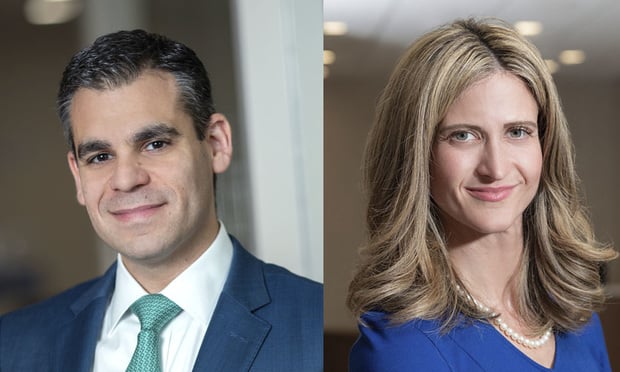Understanding Eligible Designated Beneficiaries Under the SECURE Act
It's a new year, which means new laws. Effective on Jan. 1, the SECURE Act—Setting Every Community Up for Retirement Enhancement—will dramatically change how the industry approaches estate planning by substantially reducing the payout period for many beneficiaries of retirement assets.
February 11, 2020 at 01:44 PM
4 minute read
 Matthew D'Emilio, left, and Jennifer Smith, right, of McCollom D'Emilio Smith Uebler in Wilmington, Delaware.
Matthew D'Emilio, left, and Jennifer Smith, right, of McCollom D'Emilio Smith Uebler in Wilmington, Delaware.
It's a new year, which means new laws. Effective on Jan. 1, the SECURE Act—Setting Every Community Up for Retirement Enhancement—will dramatically change how the industry approaches estate planning by substantially reducing the payout period for many beneficiaries of retirement assets.
SECURE eliminates the stretch IRA as an estate plan option, unless the beneficiary qualifies as an eligible designated beneficiary (EDB). SECURE replaces the life expectancy payout rule that was in effect for decades with a 10-year payout rule. This rule requires that all funds must be distributed out of the plan by Dec. 31 of the 10th year after the date of death of the retirement plan participant.
There are five categories of EDBs exempt from SECURE's 10-year payout rule. If a beneficiary falls into one of these five categories, she can enjoy the benefit of tax-free growth over a longer period during which the retirement assets will be distributed.
First, a surviving spouse qualifies as an EDB under SECURE, and little will change when planning for this beneficiary. A surviving spouse will still be able to elect a spousal rollover of the inherited retirement assets and treat them as her own IRA; a conduit trust for the surviving spouse can still use the life expectancy payout; and the combination QTIP-conduit trust will work the same under SECURE during the surviving spouse's life.
Second, a minor child also qualifies as an EDB. Notably, this exception is only available to the child of a retirement plan participant—it is not available to a grandchild or more remote descendant of a retirement plan participant. If a conduit trust were created for the minor, the trust would be eligible for the life expectancy payout. But once the child attains majority (18 or 21, depending on the state) the 10-year rule applies.
The third and fourth categories, though different, follow similar rules under SECURE. Beneficiaries who are disabled or chronically ill will qualify as EDBs. This status is determined at the time of the retirement plan participant's death and does not change if the beneficiary becomes disabled or chronically ill at some time after the retirement plan participant's death.
Each of these groups is granted two special breaks that apply to multi-beneficiary trusts, which are not available to the other three categories of EDBs:
- If a trust is to be divided immediately into a separate trust for each beneficiary, the life expectancy payout rule will be applied separately for the portion payable to any EDB who is disabled or chronically ill.
- If some of the trust's beneficiaries are disabled or chronically ill, then the life expectancy payout rule will apply to the EDBs, and any beneficiary who is not disabled or chronically ill will be treated as a beneficiary of the EDB upon the death of the EDB.
For the fifth and final category, a beneficiary who is less than 10 years younger than the retirement plan participant qualifies as an EDB. For example, if an 85-year-old man names his 80-year-old sister as his beneficiary, she would qualify as an EDB and she would be entitled to a life expectancy payout.
These five categories provide EDBs an exception to the new 10-year rule, but all other beneficiaries will be subject to the 10-year rule. And when an EDB dies, the EDB's beneficiaries will be subject to the 10-year rule. At this time, it is unclear what the outcome will be if an EDB designates another EDB as his beneficiary or if a trust instrument creates a trust for the benefit of another EDB after the death of the first EDB.
SECURE is in its infancy, and it will take time for the industry to sort through the many unanswered questions that it presents. One thing is certain—there is no "one-size-fits-all" solution to the planning challenges created by SECURE, and individuals should work closely with their estate planners, financial advisers and accountants to craft a plan that meets their unique needs.
Matthew D'Emilio is a managing member and Jennifer Smith is a member of McCollom D'Emilio Smith Uebler in Wilmington, Delaware. D'Emilio practices in the areas of estate planning and wealth transfer, estate and trust litigation, estate and trust administration, business transactions, and tax law. Smith practices in the areas of estate planning, estate and trust administration, tax planning wealth preservation and fiduciary litigation.
This content has been archived. It is available through our partners, LexisNexis® and Bloomberg Law.
To view this content, please continue to their sites.
Not a Lexis Subscriber?
Subscribe Now
Not a Bloomberg Law Subscriber?
Subscribe Now
NOT FOR REPRINT
© 2025 ALM Global, LLC, All Rights Reserved. Request academic re-use from www.copyright.com. All other uses, submit a request to [email protected]. For more information visit Asset & Logo Licensing.
You Might Like
View All

3rd Circuit Strikes Down NLRB’s Monetary Remedies for Fired Starbucks Workers

Middle District of Pennsylvania's U.S. Attorney Announces Resignation
2 minute read
Judicial Appointments After Casey: Observers Wary but Hopeful Bipartisan Spirit Will Continue
Trending Stories
Who Got The Work
Michael G. Bongiorno, Andrew Scott Dulberg and Elizabeth E. Driscoll from Wilmer Cutler Pickering Hale and Dorr have stepped in to represent Symbotic Inc., an A.I.-enabled technology platform that focuses on increasing supply chain efficiency, and other defendants in a pending shareholder derivative lawsuit. The case, filed Oct. 2 in Massachusetts District Court by the Brown Law Firm on behalf of Stephen Austen, accuses certain officers and directors of misleading investors in regard to Symbotic's potential for margin growth by failing to disclose that the company was not equipped to timely deploy its systems or manage expenses through project delays. The case, assigned to U.S. District Judge Nathaniel M. Gorton, is 1:24-cv-12522, Austen v. Cohen et al.
Who Got The Work
Edmund Polubinski and Marie Killmond of Davis Polk & Wardwell have entered appearances for data platform software development company MongoDB and other defendants in a pending shareholder derivative lawsuit. The action, filed Oct. 7 in New York Southern District Court by the Brown Law Firm, accuses the company's directors and/or officers of falsely expressing confidence in the company’s restructuring of its sales incentive plan and downplaying the severity of decreases in its upfront commitments. The case is 1:24-cv-07594, Roy v. Ittycheria et al.
Who Got The Work
Amy O. Bruchs and Kurt F. Ellison of Michael Best & Friedrich have entered appearances for Epic Systems Corp. in a pending employment discrimination lawsuit. The suit was filed Sept. 7 in Wisconsin Western District Court by Levine Eisberner LLC and Siri & Glimstad on behalf of a project manager who claims that he was wrongfully terminated after applying for a religious exemption to the defendant's COVID-19 vaccine mandate. The case, assigned to U.S. Magistrate Judge Anita Marie Boor, is 3:24-cv-00630, Secker, Nathan v. Epic Systems Corporation.
Who Got The Work
David X. Sullivan, Thomas J. Finn and Gregory A. Hall from McCarter & English have entered appearances for Sunrun Installation Services in a pending civil rights lawsuit. The complaint was filed Sept. 4 in Connecticut District Court by attorney Robert M. Berke on behalf of former employee George Edward Steins, who was arrested and charged with employing an unregistered home improvement salesperson. The complaint alleges that had Sunrun informed the Connecticut Department of Consumer Protection that the plaintiff's employment had ended in 2017 and that he no longer held Sunrun's home improvement contractor license, he would not have been hit with charges, which were dismissed in May 2024. The case, assigned to U.S. District Judge Jeffrey A. Meyer, is 3:24-cv-01423, Steins v. Sunrun, Inc. et al.
Who Got The Work
Greenberg Traurig shareholder Joshua L. Raskin has entered an appearance for boohoo.com UK Ltd. in a pending patent infringement lawsuit. The suit, filed Sept. 3 in Texas Eastern District Court by Rozier Hardt McDonough on behalf of Alto Dynamics, asserts five patents related to an online shopping platform. The case, assigned to U.S. District Judge Rodney Gilstrap, is 2:24-cv-00719, Alto Dynamics, LLC v. boohoo.com UK Limited.
Featured Firms
Law Offices of Gary Martin Hays & Associates, P.C.
(470) 294-1674
Law Offices of Mark E. Salomone
(857) 444-6468
Smith & Hassler
(713) 739-1250





